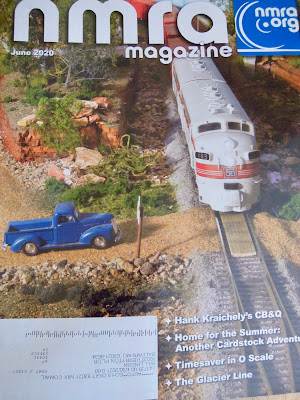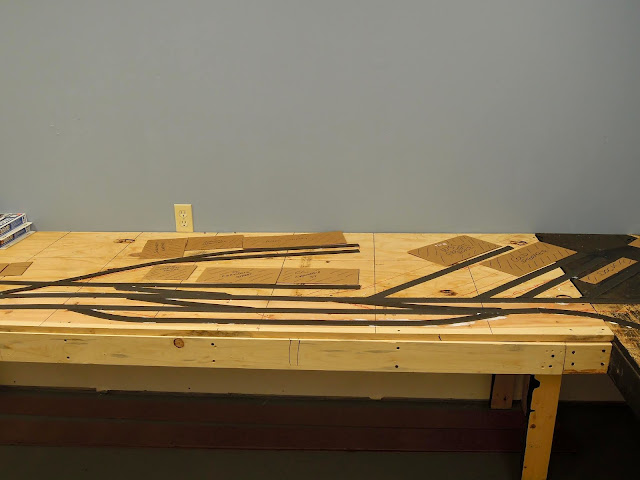I want to take this time and space to recognize some of the many outstanding modelers in the St. Louis area. The following have been featured in major model railroad publications -- five of them with cover photos in just the past few months. Admittedly, the 2020 NMRA Convention is coming to town, but that in no way lessens the work of these incredible modelers and their respective recognition by the modeling press.
Eric Booman hit the twofer when his Utah Belt was featured on the cover of the December 2018
Model Railroader and the December 2019 issue of the
NMRA Magazine. The 22' 8" x 39' 6" layout is 40 years old, but evolving motive power, industries, operation, and scenery keep the railroad, set in northern New Mexico, in the present day. Eric has long been known for retiring motive power and bringing on new, concurrent with the prototype. One of the very few departures that Eric makes from the prototype is the absence of graffiti -- he abhors it and there is none to be found on the Utah Belt. Power for the layout is DC cab control.
The Utah Belt first appeared in the model press in 1978 with a feature in
Railroad Model Craftsman, and
Model Railroader recognized it first in 1986 and several times since then.
Although they didn't make the cover, a number of other accomplished St. Louis modelers were recognized in the
December 2019 issue of the
NMRA Magazine. They include
Brad Joseph and his HO layout;
Dan McReynolds' HO scale ATSF Railway;
Randy Meyer's Sn3 Canyon & Rocky Mountain;
John Schindler (see below);
John Peluso's HO railroad;
Pete Smith's exquisite Sn3 1930's Loon Lake Railway & Navigation Co. layout featuring a number of geared locomotives;
Doug McCormick's HO Union Pacific; and
Ken Kroschwitz's monster HO layout at his hobby store.
All of the model railroads in this post will be on the Layout Tour at the convention, and several of the modelers will be among the dozens highlighted in the clinic offerings.
John Russel models the Rock Island railroad in O scale with his Rock Island Lines, and is the featured cover subject in the March 2020 issue of
Railroad Model Craftsman. Set in the 1948-1952 era, the railroad fills a 65' x 35' basement. Motive power is largely custom-painted brass imports, and to understand the level of prototype accuracy, one only has to know John worked as a trainman on "The Rock" for more than 40 years. John is well known nationally in O-scale circles, and his railroad has also been featured in
Narrow Gauge and Short Line Gazette on several occasions.
John's railroad is DC powered.
Gary Hoover is, along with Eric Brooman, one of the most recognizable names in model railroading. His latest effort is the cover subject for the April 2020 issue of
Model Railroader. The 24' x 49' Norfolk and Western of the 1950s is set in Appalachian coal country and is unique in that it includes scenes in HO scratch built models of pictures by famed railroad photographer O. Winston Link. It replaces the ATSF Railway by Gary that was featured in a 2005 issue of
Model Railroader. Prior to that railroad, he built the Missouri, Kansas, and Quincy. In addition to the covers, Gary has written many articles, and provided the photographs, for numerous national modeling publications.
This latest effort is DCC powered by Digitrax.
Gary Gross is the guru of the Franklin Pacific Railroad, a three-level HO layout set in 1958. It is the cover photo and featured article in the January 2020
NMRA Magazine. All compacted into a 12' x 20' footprint, the railroad is heavy on operations. The single set of staging tracks represents both ends of the layout: St. Louis on the east and Springfield/Kansas City on the west. As I said, Gary is devoted to operations: he uses a 4:1 fast clock, and the optimum crew is seven. Two to run Franklin Yard, a dispatcher who sits away from the railroad, and four running the trains.
Control for the Franklin Pacific is DCC.
Dave Roeder by any criteria, is a prolific award-winning modeler. His Webster Groves & Fenton Railroad is a prototype/freelance HO scale model railroad set in the mid-1980s with first and second generation diesels providing a bulk of the power. The layout is built as an operating railroad and has entertained monthly operating sessions continuously since 1996. Dave's FG&W is the cover photo and feature in the March 2020
NMRA Magazine. The layout occupies a 30' x 70' room.
Dave has won hundreds ... even thousands of awards ... in modeling, and not just in railroading. He is also a award-winning modeler of automobiles in different scales
The Webster Groves & Fenton is powered by analog DC.
John Schindler and his large St. Louis Junction railroad features action on both sides of the Mississippi River. The 30' x 60' layout was featured prominently in the March 2020
Model Railroader. It's a current era, multi-deck walk-in railroad with a mainline run of 275 feet. Crews use 40 locomotives to move some 500 cars in a typical operating session. A crew consists of eight to twelve operators, and the dispatcher uses a computer and CATS signal logic. The railroad is a Digitrax DCC layout. John is co-chair of the 2020 NMRA National Convention in St. Louis.
Featured on more than one occasion over the last several months in the
NMRA Magazine is David Lowell and his scratch-built structures and rolling stock memorializing the Chicago and Illinois Midland. His modeling is such that you will be hearing more about him in the coming months.
There's a lot of great modeling going on in the St. Louis area. This is just a tip of the iceberg.






























